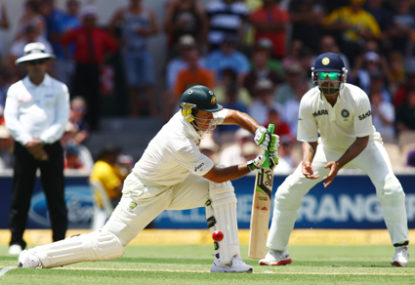Former Australian skipper Ricky Ponting is correct in wanting restrictions placed on cricket bats.
No sport has been immune to an arms race when it comes to both the changes to, and adoption of, new technology.
However, the changes in cricket have been entirely one-sided and slanted completely towards batsmen.
Other sports have dovetailed into advances in technology but in almost all cases they have not been too the detriment of certain participants within the sport.
Golf, for example, has undergone equipment changes like few other sports in the past few decades.
Today’s drivers with their graphite shafts and mostly hollow titanium or composite maxi-heads are a quantum leap when compared with the old steel shafted woods of 40 years ago.
Likewise, the modern-day milled faces on wedges create vastly more backspin than their predecessors.
These enhancements, and others, have had a dramatic impact on the sport but in the process no one was penalised, save those who did not upgrade their equipment.
The technological advances were there for everyone’s benefit, just as it has been in a sport like tennis.
Alas, in cricket that has not been the case.
The batsmen’s armoury has changed incredibly in recent times while the poor old bowler is left to combat it with the same familiar old 156g (5.5 ounce) cricket ball – the only change has been the move beyond the traditional red colour.
While the bowlers have had to develop things like reverse swing to try and outwit the batsman the willow wielders have seen constant changes to their weapon of choice.
While the MCC has steadfastly guarded the sanctity of the ball it has shown no such restraint with respect to the bat.
The modern blades dwarf their predecessors as they have morphed into bazookas.
David Warner’s bat – aptly marketed under the name ‘Kaboom’ – looks like a log compared to the bats of 20 years ago.
While the linear dimensions have not changed – under Appendix E of the Laws of Cricket, a bat can be no longer than 38 inches (965mm) in length and 4.25 inches (108mm) in width – there is no restriction on weight or thickness, and therein lies the problem.
In February last year, the ICC said it had concerns about the impact the change in bat sizes was having on the game.
ICC chief executive Dave Richardson conceded that modern bats had “shifted the balance” towards batsmen, a fact that Ponting has reiterated this week.
A report commissioned by the MCC found that while the length and width had remained constant, the thickness of the blade and the associated sweet spot had grown significantly over the past 20 years.
The report identified that the thickness of bats had increased by 22mm over the last 100 years and the area of the ‘sweet spot’ had blown out by about 250 per cent while the edges of some of the modern-day bats had increased by a whopping 300 per cent.
All this has resulted in infinitely more power to the point that mishits that would have seen players caught 25 years ago are now sailing into the stands for six.
Allied to the advantages gained by these new bats, batsmen have also been aided by the significant reduction in the size of grounds with some being roped off up to 15m short of the perimeter fence which used to form the boundary.
Bowlers have also been limited to the number of short, intimidatory deliveries they can send down each over.
In limited overs matches pitches are also frequently deadened to maximise the runs which is seen by administrators as the major selling point in enticing crowds and TV viewers.
Scoring rates have risen as a result at a rapid rate to the point that Indian Rohit Sharma’s world record ODI score of 264 would have been seen as a large team total going back 20-odd years.
Major League Baseball decided to standardise the bat by codifying it as having to be one piece of solid wood not more than 2.61 inches at the thickest part and not more than 42 inches in length.
For a period, metal bats were in use but the authorities decided to outlaw them at professional level as a result of safety concerns for the pitcher who stand at best 18.5m away.
The velocity that a ball came off a metal bat was deemed to be too dangerous for the pitcher.
In recent times, we have seen cricket umpires adopt helmets and armguards as a way of protection against balls flying off the modern bat.
Cricket at its best is a relatively even contest between bat and ball.
Presently the authorities have allowed through either inaction or deliberate decisions to too often remove that balance.
It is high time that the sport’s governors did something about it, and as Ponting asserts, the dimensions of the bat is a fine place to start.





























































































